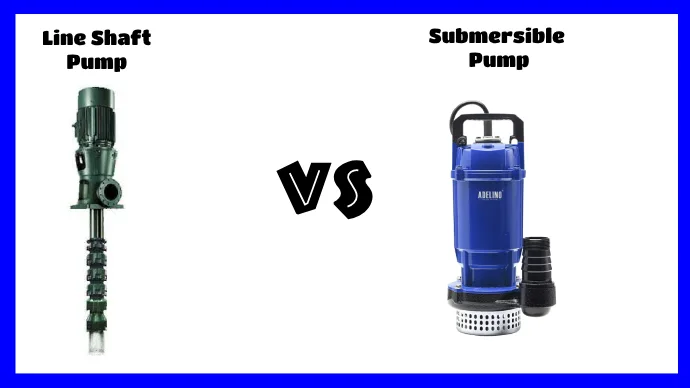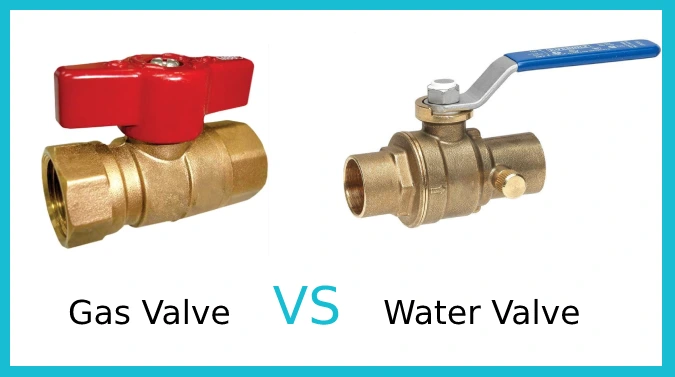Last Updated on July 23, 2023
What is the best type of pump for your water pumping needs between a line shaft and a submersible pump? Some say that submersible pumps are the way to go, while others swear by line shaft pumps (AKA vertical turbine pumps). But what is the truth? Is one really better than the other?
When considering the differences, you’ll find unique differences between the two. A line shaft pump consists of a vertical turbine pump with the moto. While a submersible pump features a pump assembly with the motor located below the pump bowl.
Today, we will comprehensively compare line shaft pumps and submersible pumps, covering everything from construction to flexibility. We will investigate the truth behind common beliefs about these pumps and provide you with the information.
Line Shaft vs Submersible Pump: A Comprehensive Comparison

When comparing line shaft pumps and submersible pumps, you’ll find unique differences between the two. The following are the key differences between these two pumps:
- Construction and Operation:
- Installation and Maintenance:
- Efficiency and Energy Consumption:
- Pump Applications:
- Noise and Aesthetics:
- Reliability and Durability:
- Flexibility and System Design:
Construction and Operation:
A line shaft pump has a motor above ground that transmits power to the impeller but the hydraulic parts are submerged into the fluid. On a submersible pump, the motor is under the bowl and it’s completely submerged in the fluid it pumps.
The construction and operation of these pumps differ significantly, as shown in the table below:
| Construction and Operation | Line Shaft Pump | Submersible Pump |
| Pump Assembly | Hydraulic parts are submerged | Submerged |
| Motor Location | Above ground | Below pump bowl |
| Transmission of Power | Line shaft connected to motor | Motor directly powers impeller |
| Fluid Being Pumped | Can be above ground or at a distance | Must be submerged |
Installation and Maintenance:
You can ensure efficient operation and minimize downtime by properly installing and regularly maintaining your pump. Here are four key points to consider when it comes to the installation and maintenance of line shaft and submersible pumps:
- Line shaft pumps are typically easier to install as they require the pump to be installed above the water surface. This allows for easier access for installation, maintenance, and repair due to the above-ground motor location. Regular maintenance involves lubricating line shafts and bearings.
- Submersible pumps, conversely, require the pump assembly to be lowered directly into the fluid being pumped. While installation may be more time-consuming, submersible pumps generally have fewer moving parts, potentially lowering maintenance requirements.
- To properly install a line shaft pump, the pump should be placed above ground level and aligned with the motor. The line shaft should be lubricated regularly to ensure proper operation.
- For submersible pumps, proper installation involves ensuring that the pump is submerged at the correct depth and aligned with the motor. Regular maintenance involves pulling the entire pump assembly out of the fluid for inspection and repair.
Efficiency and Energy Consumption:
In this context, submersible pumps have a distinct advantage over line shaft pumps. The direct immersion of the impeller in the fluid being pumped eliminates energy losses associated with long shafts and couplings, resulting in a higher level of energy efficiency.
Also, the higher operating speeds of submersible pumps allow them to handle high flow rates from reduced diameter boreholes, further contributing to their overall efficiency.
In contrast, line shaft pumps may have lower energy efficiency due to energy losses through the long vertical shaft and couplings. The transmission of power from the motor to the impeller can also result in energy losses. Moreover, line shaft pumps may experience efficiency loss due to impeller wear over time.
Pump Applications:
If you are looking for a pump that can handle various applications, consider factors such as flow rate, pressure requirements, and fluid type.
Both line shaft and submersible pumps have their unique applications and advantages. Line shaft pumps are well-suited for high-pressure applications such as water supply, firefighting, sewage systems, and irrigation.
Alternatively, submersible pumps are more commonly used in domestic, commercial, and industrial settings for well pumping, groundwater extraction, sump pumps, and underwater applications.
To provide a clearer picture of the applications of line shaft and submersible pumps, refer to the table below:
| Pump Type | Applications |
| Line Shaft | Water supply, Sewage systems, Firefighting, Irrigation |
| Submersible | Domestic, Commercial, Industrial, Well pumping, Groundwater extraction, Sump pumps, Underwater applications |
Noise and Aesthetics:
When choosing a pump, it’s important to consider the impact of noise and aesthetics on the surrounding environment. In this regard, choosing between a line shaft and a submersible pump can make a significant difference.
Here’s why:
- Line shaft pumps can generate more noise during operation, which can be a concern in residential areas or places needing quiet operation. The above-ground motor and associated components may contribute to the noise levels, making it less appealing in terms of noise pollution.
- Conversely, submersible pumps operate at lower decibel levels, offering quieter operation. This can be a significant advantage in areas where noise pollution is a concern.
Reliability and Durability:
Line shaft pumps are known to have potential shaft straightness issues and line-shaft bearing problems. These issues can cause vibration and wear vulnerabilities, leading to premature failure of the pump. But motor replacement is generally easier since the motor is above ground.
In contrast, submersible pumps eliminate the vibration and wear vulnerabilities associated with line shafts and bearings.
However, they can be more prone to failure due to overloads, low voltage, and voltage spikes in harsh environments. Moreover, motor replacement requires pulling out the entire pump assembly, which can be time-consuming and expensive.
Flexibility and System Design:
Providing more options for pump placement and system design, the line shaft pump offers greater flexibility than the submersible pump.
With a line shaft pump, the motor is located above ground and connected to the pump via a drive shaft. This allows for greater freedom in designing the system layout, as the pump can be placed further away from the water source and still function effectively.
Alternatively, the submersible pump must be submerged in the fluid being pumped, which limits its placement options. It requires suitable water depths or well casings for installation and may not be suitable for all situations.
However, once installed, submersible pumps are generally more efficient than line shaft pumps, as they operate with fewer energy losses due to the absence of a drive shaft.
What is the major disadvantage of a submersible pump?

You’ll find that the major disadvantage of a submersible pump is its difficult-to-repair seal. This seal can become corroded over time, allowing water to seep into the motor and render it useless until it’s repaired.
In addition, the seal also makes the submersible pump difficult to access for repairs. Here are five reasons why the seal on a submersible pump can be a major disadvantage:
- The seal’s located deep in the ground, making it challenging to reach for repairs.
- The seal can become corroded with time, leading to costly repairs.
- The seal can be difficult to replace, requiring specialized tools and expertise.
- If the seal fails, it can cause water damage to the motor and other components, leading to further repairs.
- The seal can also make performing routine maintenance on the pump challenging.
How long do vertical turbine pumps last?
A Line Shaft Pump, also known as a Vertical Turbine Pump, can perform for up to 15 to 25 years without any issues in clean water applications, and some even last longer.
These pumps are known for their robust structure, durability, and low maintenance requirements. They are designed to handle high flow rates and are perfect for water supply applications in commercial and industrial settings.
What are the disadvantages of vertical pumps?
Vertical pumps can be challenging to install and maintain due to their need for significant headroom, a pit, and a bucket, especially larger multistage pumps. The installation process requires the excavation of a sump or pit, which is not only time-consuming but also adds to the overall cost of the system.
Also, vertical pumps require significant headroom above the installation site, which can be challenging in environments with limited space. When the pump is in a remote or hard-to-access place, a bucket and pit make it harder to inspect and maintain.
Furthermore, vertical centrifugal pumps can only be coupled to an electric motor, limiting their versatility. If the electric motor fails, the entire pump system will fail, leading to costly downtime.
Also, vertical pumps require a lot of energy to operate since they must overcome the gravitational forces acting on the water. This can make them more expensive to operate and maintain than other pumps.
How far can you pump water vertically with a Line Shaft Pump?
The maximum height that a line shaft pump can lift water depends on several factors, including the pump’s efficiency, the diameter of the pipe, and the atmospheric pressure at the location.
Here are three key factors that affect the height:
- Pump efficiency: Line Shaft Pump’s efficiency decreases as the height it needs to lift water increases. This means the higher the pump has to lift water, the less water it can pump out per unit of energy input.
- Pipe diameter: The diameter of the pipe used to transport water also affects how high a Line Shaft Pump can lift water. Smaller pipe diameters mean more friction, which can reduce the pump’s efficiency and limit how high it can lift water.
- Atmospheric pressure: The atmospheric pressure at a given location determines how high a pump can lift water. Line Shaft Pumps can lift the water up to 33.9 feet at sea level.
Line Shaft vs Submersible Pumps: Make the Right Choice for Your Water Pumping Needs
Choosing the right pump for your water pumping needs is crucial. With this comprehensive comparison, you better understand the differences between the line shaft and submersible pumps.
If you’re looking for a pump that’s easy to maintain and repair, the line shaft pump is an excellent choice. But, if you need to pump water from a deep well, a submersible pump is your best bet.
Moreover, if you’re looking for a pump that can last decades, the Vertical Turbine Pump (commonly used with the Line Shaft Pump) can last up to 25 years. Conversely, the Submersible Pump may have a shorter lifespan due to its submersion in water, which can cause corrosion.
It’s your responsibility to weigh the differences and choose the one that best suits your needs. Remember to consider factors such as maintenance, repair, durability, and depth of the well. Happy pumping!



